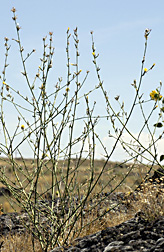Washington, DC
July 30, 2009
Agricultural Research Service, USDA
By
Stephanie Yao
 Finding
effective biocontrols against rush skeletonweed could be easier
now that all genotypes of the invasive weed have been identified
in North America by an
Agricultural
Research Service (ARS) scientist and his collaborators. Finding
effective biocontrols against rush skeletonweed could be easier
now that all genotypes of the invasive weed have been identified
in North America by an
Agricultural
Research Service (ARS) scientist and his collaborators.
Rush skeletonweed,
Chondrilla juncea, poses a threat to irrigated lands,
dryland cropping areas and rangelands. It affects the cattle
industry by displacing beneficial forage plant species, and its
tall, wiry stems hinder the operation of crop harvest machinery.
The weed also invades forests, outcompeting native plants for
valuable nutrients.
The weed is mainly found in the
Pacific Northwest, where it has spread rapidly during the past
few decades. However, according to herbarium records, rush
skeletonweed first invaded the eastern United States in the
1870s; it didn't appear in the western states until the 1930s.
Since the weed is now rarely found in the eastern part of the
country, scientists are unsure whether the western invasion
originated from the eastern United States or overseas.
Current biocontrol agents--a
gall midge, a gall mite and a rust fungus--do not appear to be
effectively controlling the plant's population, in part because
not all agents are effective against all genotypes of the weed.
Seeing this predicament,
botanist
John Gaskin, with the
ARS Pest Management Research Unit in Sidney, Mont., and his
colleagues from the University
of Idaho and the
U.S.
Department of Agriculture (USDA) Forest Service's
Rocky Mountain Research
Station began researching the weed's genealogy in hopes of
finding a solution.
The team asked county weed
agencies from the United States and Canada to submit samples for
DNA testing. After examining more than 700 samples, Gaskin found
that only seven North American genotypes exist, five of which
reside in the Pacific Northwest.
The group has also found that
invasions in Australia and Argentina each contain distinct
genotypes. They will be matching invasive genotypes worldwide
against those found in the weed's native Eurasian range. This
will help with selecting and testing new biocontrol agents and
determining where to implement them.
Read more about this research in the July 2009 issue of
Agricultural Research magazine.
ARS is USDA's principal
intramural scientific research agency.
Encontrar biocontroles eficaces
para controlar el yuyo esqueleto (Chondrilla juncea)
ahora podría ser más fácil con la identificación de todos los
genotipos de esta maleza invasora en Norteamérica por un
científico del
Servicio de Investigación Agrícola (ARS) y su colaboradores.
El yuyo esqueleto representa
una amenaza a los terrenos regados, las áreas de cultivos sin
riego, y los terrenos de pasto. La maleza también afecta el
sector de ganado bovino desplazando las especies beneficiosas de
plantas de forraje, y sus tallos altos y fuertes impiden el
funcionamiento de las máquinas de cosecha. La maleza también
invade los bosques y consume nutrientes valiosos necesitados por
las plantas nativas.
El yuyo esqueleto se encuentra
principalmente en la región Pacífico Noroeste de EE.UU., donde
se ha extendido rápidamente durante las últimas décadas. Sin
embargo, según los archivos de herbarios, el yuyo esqueleto
invadió la región oriental de EE.UU. por primera vez durante los
años 1870, y no llegó en los estados occidentales hasta los años
1930. Ya que la maleza ahora se encuentra pocas veces en la
región oriental de EE.UU., científicos no saben si la invasión
occidental tiene su origen en la región oriental de EE.UU. o en
otro país.
Agentes actuales de biocontrol,
tales como una mosca agalladora, un ácaro agallador y un hongo
de tizón, no parecen controlar eficazmente la población de la
maleza, en parte porque los varios agentes de biocontrol varían
en su eficacia contra los genotipos diferentes de la maleza.
Por consiguiente, botánico
John Gaskin, quien trabaja en la
Unidad de Investigación del Manejo de Plagas mantenida por
el ARS en Sidney, Montana, y sus colegas de la
Universidad de Idaho y de
la Estación de
Investigación de las Montañas Rocosas, mantenida por el
Servicio Forestal del
Departamento de Agricultura de EE.UU. (USDA por sus siglas
en inglés), comenzaron a investigar la genealogía de la maleza
con la esperanza de encontrar una solución.
El grupo obtuvo muestras de la
maleza de agencias de control de malezas en condados en EE.UU. y
Canadá, y luego probaron el ADN de las muestras. Después de
examinar más de 700 muestras, Gaskin descubrió que hay solamente
siete genotipos norteamericanos de esta maleza, y cinco de ellos
se encuentran en el Pacífico Noroeste.
Los científicos también
descubrieron que cada una de las invasiones de esta maleza en
Australia y Argentina incluye genotipos distintos. Los
investigadores compararán los genotipos invasores de todas
partes del mundo con aquellos encontrados en la tierra natal
euroasiática de la maleza. La información derivada de esta
comparación ayudará con la selección y las pruebas de nuevos
agentes de biocontrol y decisiones sobre dónde implementarlos.
Lea más sobre esta investigación en la revista 'Agricultural
Research' de julio del 2009.
ARS es la agencia principal
de investigaciones científicas del USDA. |